Looking for a student learning guide? It’s linked in the main menu for your course. Use the “Courses” menu above.
1. Adaptive Radiation and Homologous structures
1a. Adaptive radiation results in differentiation

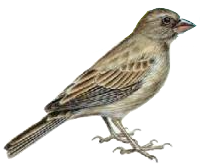 Here’s a story about songbird evolution on an an island chain.
Here’s a story about songbird evolution on an an island chain.
- Roman numerals I through V represent a time sequence that begins with I ends with V.
- Letters A through E represent different songbird species.
- Letter w represents a continent. Letters x, y, and z represent the islands in an island chain that’s at some distance away.
- Numbers 1 through 9 represent speciation events (events that form new species).
Note that we’ll cover how speciation works in the next module.
In diagram I, there’s only one songbird species, A. It lives on continent “w.” Islands x, y, and z are beyond the normal migration range of species A. However, a storm blows a small population of A out to sea. Instead of perishing, they land on island “x” (event 1).
In diagram II, the different environment on island x places selective pressure on the new arrivals from species A. Over time, they evolve enough genetic differences to qualify as a new species, distinct from species A. This is event 2, and it creates species B. In addition, some members of species B migrate over to island y (event 3)
In diagram III, different selective pressures on island y cause the birds there to evolve into species C (event 4). These birds have become so different from their ancestors that when some migrate back to island x, they no longer interbreed with species B (event 6). At the same time, some members of species C migrate over to island z (event 5).
In diagrams IV and V, additional migrations followed by differentiation lead to the production of four descendant species (B, C, D, and E). Species A continues to exist on continent “w,” for a total of 5 species.
Continue with the interactive reading below.
[qwiz qrecord_id=”sciencemusicvideosMeister1961-Evidence for evo: adaptive radiation and homology”]
[h]Interactive Reading: Adaptive radiation and descent with modification
[i]When one species branches into numerous descendants, it’s called adaptive radiation. This process can happen anywhere, but it’s frequently associated with island chains. The word “radiation,” in this context, means “spreading out.” Click the “start quiz” button to learn about the consequences of adaptive radiation, and how these consequences come to constitute evidence for evolution.
[q labels = “top”]For a bird, the most important way that it ___________ with its ______________ is through its ________. Connect that to the scenario above. One of the ways that the bird populations will respond to different ____________ pressures on each island will be to evolve changes in the form of their ___________.
[l]beak
[fx] No, that’s not correct. Please try again.
[f*] Correct!
[l]environment
[fx] No. Please try again.
[f*] Correct!
[l]interacts
[fx] No, that’s not correct. Please try again.
[f*] Good!
[l]selective
[fx] No. Please try again.
[f*] Correct!
[q]As adaptive radiation occurs, instead of just one beak ______________, there will be multiple phenotypes. Some populations might be _____________ for larger, more powerful beaks, enabling them to crush larger seeds. Some might be selected for more ____________ beaks, enabling them to probe into flowers and sip nectar (like a hummingbird).
If the image below represents the ancestor, imagine what each daughter species’ beak might look like.
[l]slender
[fx] No, that’s not correct. Please try again.
[f*] Correct!
[l]phenotype
[fx] No. Please try again.
[f*] Good!
[l]selected
[fx] No, that’s not correct. Please try again.
[f*] Correct!
[q labels = “top”]This diagram shows the finches on the Galapagos islands, an island chain located about 1000 kilometers off the coast of Ecuador. The diagram is asserting that one ___________ species evolved into several ____________ species. In each one, there’s a different beak _____________. Connecting this to the material you’ve been reading about, what you’re seeing is an example of ____________ ____________.
[l]adaptive
[fx] No. Please try again.
[f*] Good!
[l]ancestral
[fx] No, that’s not correct. Please try again.
[f*] Excellent!
[l]descendant
[fx] No, that’s not correct. Please try again.
[f*] Correct!
[l]phenotype
[fx] No. Please try again.
[f*] Correct!
[l]radiation
[fx] No, that’s not correct. Please try again.
[f*] Correct!
[q labels = “top”]The beaks of the Galapagos finches are _____________ that have evolved slightly different _______________. In each species, there’s been ___________ with ______________. But because of different ________________ pressures, the modification is different in each case.
[l]descent
[fx] No, that’s not correct. Please try again.
[f*] Good!
[l]functions
[fx] No. Please try again.
[f*] Excellent!
[l]modification
[fx] No, that’s not correct. Please try again.
[f*] Great!
[l]selective
[fx] No, that’s not correct. Please try again.
[f*] Excellent!
[l]structures
[fx] No. Please try again.
[f*] Excellent!
[/qwiz]
1b. Differentiation from a common ancestor results in homologous structures
Structures that are inherited from a common ancestor and which have evolved different functions are called homologous structures. The related noun is homology, defined by Merriam Webster as a “likeness in structure between parts of different organisms …. due to evolutionary differentiation from a corresponding part in a common ancestor.”
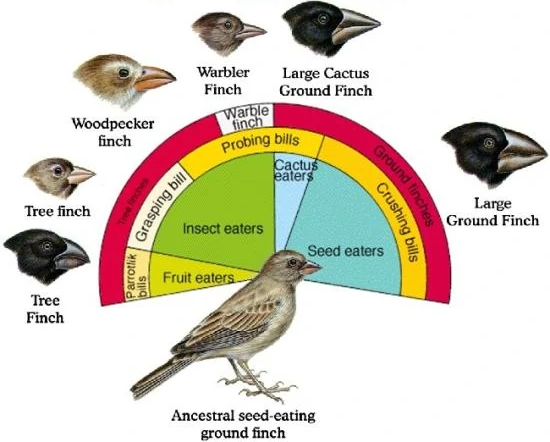 Following this definition, the beaks of the Galapagos finches are homologous. They’re structures that evolved from a related structure in a common ancestor, and differentiated into different forms as each population adapted to specific environments. Each beak became specifically adapted to enable each evolving species to fill a specific ecological niche. An ecological niche is the way that a species makes its living.
Following this definition, the beaks of the Galapagos finches are homologous. They’re structures that evolved from a related structure in a common ancestor, and differentiated into different forms as each population adapted to specific environments. Each beak became specifically adapted to enable each evolving species to fill a specific ecological niche. An ecological niche is the way that a species makes its living.
Here are two examples.
- The large ground finch evolved into a seed-eating niche.
- The woodpecker finch evolved into an insect-eating niche.
As each population evolved into these specific niches, selective pressure modified their beaks into a shape that was optimized for the type of food they eat.
 This type of adaptive radiation giving rise to homologous structures can best be represented by a phylogenetic tree. A phylogenetic tree shows evolutionary relationships among various species. Here’s a phylogenetic tree for six of the Galapagos finch species.
This type of adaptive radiation giving rise to homologous structures can best be represented by a phylogenetic tree. A phylogenetic tree shows evolutionary relationships among various species. Here’s a phylogenetic tree for six of the Galapagos finch species.
Adaptive radiation leading to homologous structures in related species is one of the most fundamental patterns in living things. It shows up everywhere: in physical structures (morphology); in genes, in metabolic pathways.
Homology is perhaps the most powerful piece of evidence for evolution.
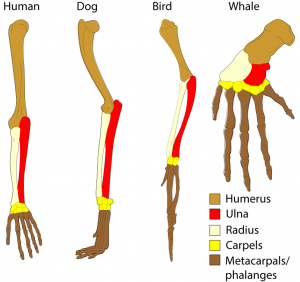
Let’s look at the bones that make up the forelimbs of humans, dogs, birds and whales. These structures, which make up the arm, forelimb, wing, and flipper of each respective animal, have the same underlying structure. They’re composed of the same bones.
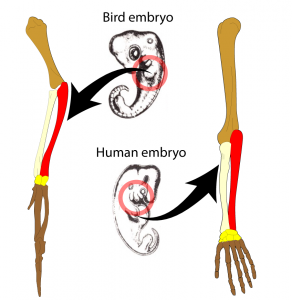 How do we know that they’re the same bones? First, because of their similar position and relationship to one another. Second, because they develop from the same tissue in the embryonic form of each animal.
How do we know that they’re the same bones? First, because of their similar position and relationship to one another. Second, because they develop from the same tissue in the embryonic form of each animal.
You can see this is the diagram to the right. Early in embryonic development, a patch of tissue differentiates to form a limb bud, circled in red. In embryos at the same developmental phase, this tissue is identical in form. However, as the animal develops into its adult form, the limb further differentiates into the form characteristic of its species.
Why are all vertebrate forelimbs composed of the same bones, and why do they develop from the same embryonic tissue? Because all of these animals share a common ancestor. Through adaptive radiation, the ancestral species split into several lineages. In each lineage, selective pressure led to the development of unique adaptations shared by that evolutionary group. In the group humans belong to, selection was for an opposable thumb and the high degree of forearm rotation found in all primates. That’s an adaptation for life in trees. In the group that led to whales, selective pressure modified the forelimb into a flipper. In birds, different selective pressures modified this form into a wing. In dogs and other carnivores, they became the forelimb characteristic of dogs, cats, bears etc.
What was this common ancestor like? It wasn’t some animal that mixed the features of humans, dogs, birds, and whales. Rather, the common ancestor of all of the four-limbed vertebrates (amphibians, reptiles, birds, and mammals) was a lobe-finned fish, similar to the extinct Eusthenopteron shown below.

Looking at vertebrate forelimbs (as well as the beaks of the Galapagos finches), you can see why homologous structures have been compared to the musical form of “theme and variations.” This form, popular in classical music, takes a melody (the theme), and then modifies it (producing the variations). In evolution, the theme is the structure in the common ancestor; the variations are the specific adaptations in the descendants.
Why are homologous structures evidence for evolution? Because they confirm the claim of descent with modification. Homologous structures only make sense if seen as having evolved from a shared ancestor which diverged, over evolutionary time to form several related descendant species.
In what follows, we’ll look at other categories of evidence for evolution. But first, let’s consolidate our understanding with a quiz.
1c. Checking Understanding: Homologous Traits
[qwiz qrecord_id=”sciencemusicvideosMeister1961-Evidence for evo: homologous traits”]
[h]Homologous Traits
[i]Biohaiku
Homologous traits
Evidence of shared descent
From one ancestor
[q]When one species branches into two or more descendants, it’s called [hangman] [hangman].
[c]YWRhcHRpdmU=[Qq]
[c]cmFkaWF0aW9u[Qq]
[q]Adaptive radiation leads to two or more daughter species. As each species adapts to a different environment, different selective [hangman] will produce distinct adaptations in each descendant. In the case of these Galapagos finches, selection is for distinctly shaped [hangman].
[c]cHJlc3N1cmVz[Qq]
[c]YmVha3M=[Qq]
[q]These beaks below are modified forms of an ancestral structure in a shared ancestor. Therefore, we can say that they’re [hangman] structures.
[c]aG9tb2xvZ291cw==[Qq]
[q]Ecologically speaking, we can say that the unique beak phenotype in each finch species is an adaptation for a specific way of making a living, also known as an ecological [hangman].
[c]bmljaGU=[Qq]
[q]The diagram below is showing another facet of the idea of [hangman]. We know that the structures are [hangman] because they originate from the same tissue in the [hangman]
[c]aG9tb2xvZ3k=[Qq]
[c]aG9tb2xvZ291cw==[Qq]
[c]ZW1icnlv[Qq]
[/qwiz]
2. Vestigial Traits are a special type of homology
2a. The Case of the Blind Cave Tetra
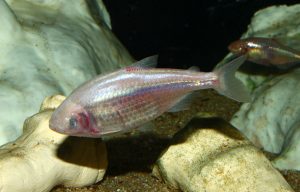
The Mexican tetra (Astyanax mexicanus) is a small, freshwater fish found in Eastern Mexico, with a range that extends north into Texas. In many areas, these fish live in water-filled caves. Some of these cave-dwelling populations have lost much of their vision. Some have lost all of their vision. Some have lost their eyes.
About 30 different cave populations have been identified. None have achieved the status of a distinct species. They can all interbreed with surface fish and produce fertile offspring.
Why would fish populations that live in caves lose their vision? There are a couple of reasons:
- Fish that live in caves can have mutations in genes that control the eyes’ structure or function, and suffer no loss in fitness. Thus, alleles for these mutations never get removed from these populations’ gene pools. Over time, these mutations can accumulate, causing average vision to get worse and worse from generation to generation.
- Eyes, and the nerve cells that support them, are complex structures. They require energy to build, maintain, and repair. In a situation where eyes are of little benefit, genes for smaller, less functional eyes can benefit survival. Instead of supporting eyes, energy can be devoted to other activities related to survival and reproduction.
So, instead of functioning eyes, cave fish often have just a trace of an eye left. Such a trace of an organ that once played a functional, adaptive role in an ancestor is called a vestigial organ. In more general terms, a vestigial, structure is one that has lost its function, and only remains in a reduced or rudimentary form.
Why don’t these structures go away altogether? Sometimes they do. But there are a couple of reasons why a vestigial structure might be maintained.
- Once the structure becomes reduced, there’s little energy cost involved in maintaining it, and very little selective pressure to reduce it further.
- The genes for the structure might be involved in other functions or process that are still important to survival. It might be impossible to turn off these genes without having negative effects that would reduce the organism’s overall fitness.
2b. Additional Examples of Vestigial Traits
 You don’t have to look very far to find other examples of vestigial traits.
You don’t have to look very far to find other examples of vestigial traits.
Our ears are wired up with muscles. But can you move your ears at will? Some people can, but most can’t. And, even if you can move your ears, you can’t move them in the adaptive way that other mammals can. The muscles are a vestigial trait. They’re a vestige or remnant of our mammalian past, when our ancient, non-human ancestors were able to move their ears to focus sounds.
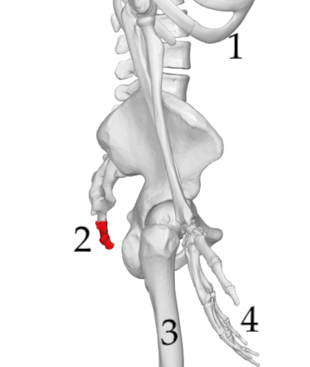
Here’s another human vestigial trait: Humans belong to group of mammals called primates. Most primates, such as monkeys and lemurs, have tails. Within the primates, we belong to the the family hominidae, or great apes. This group includes chimpanzees, gorillas, and orangutans. All of the species within this family lost their tails during the course of evolution. But we still have a vestige of a tail. It’s our coccyx, or tailbone. The coccyx is shown at “2” in the image to your right.
2c. Vestigial Traits: Checking Understanding
[qwiz qrecord_id=”sciencemusicvideosMeister1961-Evidence for evo: vestigial triats”]
[h] Vestigial Traits: Checking Understanding
[i]Biohaiku
Vestigial traits
Structures without a function
Remnants of the past
[q labels = “top”]The diagram below shows the skeleton of a __________.We’ve already discussed above how the bones of the flipper at “b” are _____________ to the bones making up the __________ of other vertebrates. The bones at “c” are another homology. They’re the whale’s ______ bones. But their shrunken and rudimentary form indicates that these legs are, in modern whales, a ___________ structure.
[l]forelimb
[f*] Good!
[fx] No, that’s not correct. Please try again.
[l]homologous
[f*] Great!
[fx] No. Please try again.
[l]leg
[f*] Good!
[fx] No, that’s not correct. Please try again.
[l]vestigial
[f*] Excellent!
[fx] No, that’s not correct. Please try again.
[l]whale
[f*] Great!
[fx] No. Please try again.
[q] Study this reconstruction of whale evolution, and then proceed to the next card
[q labels = “top”]Whales evolved from four limbed mammalian ____________. As these mammals adapted to life in the ______, there was strong selective ____________ for a streamlined, hydrodynamic shape that reduced drag. In the water, the _______ limbs that were once useful for walking and running became a liability. Any whale ancestor with smaller legs would have a survival ____________: it could swim faster, and expend less ___________.
[l]advantage
[f*] Good!
[fx] No, that’s not correct. Please try again.
[l]ancestors
[f*] Good!
[fx] No. Please try again.
[l]energy
[f*] Excellent!
[fx] No. Please try again.
[l]hind
[f*] Great!
[fx] No. Please try again.
[l]pressure
[f*] Correct!
[fx] No, that’s not correct. Please try again.
[l]sea
[f*] Excellent!
[fx] No. Please try again.
[q] Just to recap, both “b” and “c” in the diagram below are [hangman] to structures in other vertebrates. But while “b” is a functional structure, “c” is a [hangman] structure. Once the leg bones had retreated entirely into the body, there was no selective [hangman] for their further reduction. Whales today retain this tiny vestige, evidence of their [hangman] with [hangman] from a four-legged mammalian ancestor.
[c]IGhvbW9sb2dvdXM=[Qq]
[f]IEV4Y2VsbGVudCE=[Qq]
[c]IHZlc3RpZ2lhbA==[Qq]
[f]IENvcnJlY3Qh[Qq]
[c]IHByZXNzdXJl[Qq]
[f]IEV4Y2VsbGVudCE=[Qq]
[c]IGRlc2NlbnQ=[Qq]
[f]IEV4Y2VsbGVudCE=[Qq]
[c]IG1vZGlmaWNhdGlvbg==[Qq]
[f]IEdvb2Qh[Qq]
[q] In the diagram below, the vestigial trait is at number
[textentry single_char=”true”]
[c]ID I=[Qq]
[f]IEV4Y2VsbGVudC4gTnVtYmVyICYjODIyMDsyJiM4MjIxOyBpcyB0aGUgY29jY3l4LCBhIHZlc3RpZ2lhbCBzdHJ1Y3R1cmUgdGhhdCYjODIxNztzIGEgbGVmdG92ZXIgZnJvbSBvdXIgdGFpbC1iZWFyaW5nIHByaW1hdGUgYW5jZXN0b3JzLg==[Qq]
[c]IEVudGVyIHdvcmQ=[Qq]
[c]ICo=[Qq]
[f]IE5vLiBUcnkgdG8gaWRlbnRpZnkgdGhlIHBhcnQgdGhhdCYjODIxNztzIGEgcmVtbmFudCAob3IgdmVzdGlnZSkgb2YgYSBwYXJ0IHRoYXQgaGFkIGEgZnVuY3Rpb24gaW4gb25lIG9mIG91ciBhbmNlc3RvcnMu[Qq]
[q] In the diagram below, structures “3” and “4” are not considered to be [hangman] because they have a clear
[hangman].
[c]IHZlc3RpZ2lhbA==[Qq]
[c]IGZ1bmN0aW9u[Qq]
[q]One path to vestigiality is when [hangman] can occur in the genes for a structure, but with no loss in evolutionary [hangman]. That could be because the structure no longer serves as an [hangman]. As a result, these mutations never get removed from the population’s [hangman] pool.
[c]bXV0YXRpb25z[Qq]
[c]Zml0bmVzcw==[Qq]
[c]YWRhcHRhdGlvbg==[Qq]
[c]Z2VuZQ==[Qq]
[q]Structures can become vestigial because evolution has a kind of “[hangman] it or lose it” dynamic. Complex structures take [hangman] to build, maintain, and repair. If the structure doesn’t increase fitness, then the energy used to support that structure can be diverted to other structures that increase an organisms evolutionary [hangman].
[c]dXNl[Qq]
[c]ZW5lcmd5[Qq]
[c]Zml0bmVzcw==[Qq]
[q]Why don’t vestigial structures entirely disappear? One reason is that once a structure becomes reduced, there’s little [hangman] required to maintain it. Therefore, there’s very little [hangman] pressure to reduce it further. A second reason is that the genes for that structure, or the structure itself, might be related to other [hangman] that are essential to the organism’s survival or reproductive success. In that case, complete disappearance of a structure would reduce [hangman].
[c]ZW5lcmd5[Qq]
[c]c2VsZWN0aXZl[Qq]
[c]ZnVuY3Rpb25z[Qq]
[c]Zml0bmVzcw==[Qq]
[/qwiz]
Links
- The Fossil Record (the next tutorial in this module)
- Evidence for Evolution Menu
